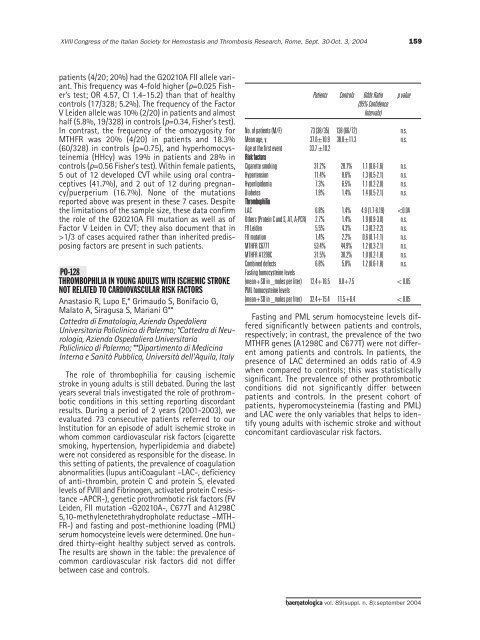XVIII Congress of the Italian Society for Hemostasis and Thrombosis Research, Rome, Sept. 30-Oct. 3, <strong>2004</strong>159patients (4/20; 20%) had the G20210A FII allele variant.This frequency was 4-fold higher (p=0.025 Fisher'stest; OR 4.57, CI 1.4-15.2) than that of healthycontrols (17/328; 5.2%). The frequency of the FactorV Leiden allele was 10% (2/20) in patients and almosthalf (5.8%, 19/328) in controls (p=0.34, Fisher's test).In contrast, the frequency of the omozygosity forMTHFR was 20% (4/20) in patients and 18.3%(60/328) in controls (p=0.75), and hyperhomocysteinemia(HHcy) was 19% in patients and 28% incontrols (p=0.56 Fisher's test). Within female patients,5 out of 12 developed CVT while using oral contraceptives(41.7%), and 2 out of 12 during pregnancy/puerperium(16.7%). None of the mutationsreported above was present in these 7 cases. Despitethe limitations of the sample size, these data confirmthe role of the G20210A FII mutation as well as ofFactor V Leiden in CVT; they also document that in>1/3 of cases acquired rather than inherited predisposingfactors are present in such patients.PO-128THROMBOPHILIA IN YOUNG ADULTS WITH ISCHEMIC STROKENOT RELATED TO CARDIOVASCULAR RISK FACTORSAnastasio R, Lupo E,* Grimaudo S, Bonifacio G,Malato A, Siragusa S, Mariani G**Cattedra di Ematologia, Azienda OspedalieraUniversitaria Policlinico di Palermo; *Cattedra di Neurologia,Azienda Ospedaliera UniversitariaPoliclinico di Palermo; **Dipartimento di MedicinaInterna e Sanità Pubblica, Università dell'Aquila, ItalyThe role of thrombophilia for causing ischemicstroke in young adults is still debated. During the lastyears several trials investigated the role of prothromboticconditions in this setting reporting discordantresults. During a period of 2 years (2001-2003), weevaluated 73 consecutive patients referred to ourInstitution for an episode of adult ischemic stroke inwhom common cardiovascular risk factors (cigarettesmoking, hypertension, hyperlipidemia and diabete)were <strong>no</strong>t considered as responsible for the disease. Inthis setting of patients, the prevalence of coagulationab<strong>no</strong>rmalities (lupus antiCoagulant –LAC-, deficiencyof anti-thrombin, protein C and protein S, elevatedlevels of FVIII and Fibri<strong>no</strong>gen, activated protein C resistance–APCR-), genetic prothrombotic risk factors (FVLeiden, FII mutation -G20210A-, C677T and A1298C5,10-methylenetethrahydropholate reductase –MTH-FR-) and fasting and post-methionine loading (PML)serum homocysteine levels were determined. One hundredthirty-eight healthy subject served as controls.The results are shown in the table: the prevalence ofcommon cardiovascular risk factors did <strong>no</strong>t differbetween case and controls.Patients Controls Odds Ratio p value(95% ConfidenceIntervals)No. of patients (M/F) 73 (38/35) 138 (66/72) n.s.Mean age, y. 37.6±10.9 38.8±11.3 n.s.Age at the first event 33.7 ±10.2Risk factorsCigarette smoking 31.2% 28.7% 1.1 (0.6-1.6) n.s.Hypertension 11.4% 8.6% 1.3 (0.5-2.1) n.s.Hyperlipidemia 7.3% 6.5% 1.1 (0.2-2.0) n.s.Diabetes 1.9% 1.4% 1.4 (0.5-2.1) n.s.ThrombophiliaLAC 6.8% 1.4% 4.9 (1.7-8.19)
160PostersPO-129RISK FACTOR FOR EXTRA-HEPATIC PORTAL VEINOBSTRUCTIONBattaglioli T,* Martinelli I,* Bucciarelli P,* Reati R,°Fabris F,° Primignani M,° Mannucci PM**Angelo Bianchi Bo<strong>no</strong>mi Hemophilia andThrombosis Center and °Gastroenterology Unit,Department of Internal Medicine and Dermatology,IRCCS Ospedale Maggiore Policlinico, Universityof Mila<strong>no</strong>, ItalyHereditary thrombophilia is associated with anincreased risk of deep vein thrombosis (DVT), but fewinformation is avaliable on its role in patients withextra-hepatic portal vein obstruction (EHPVO). Wecarried out a case-control study on 65 patientsreferred to the Thrombosis Center (January 1994 toMay 2003) for a thrombophilia screening after a firstepisode of EHPVO and 700 healthy controls. Fivehundred patients with a first episode of lower limbDVT (LL-DVT) referred in the same study period werealso investigated. Screening for hereditary thrombophiliaand hyperhomocysteinemia was performed.Transient risk factors for thrombosis at the time ofthrombosis (for patients) or the visit (for controls)were recorded. The prevalence of thrombophilicab<strong>no</strong>rmalities in EHPVO patients, LL-DVT patientsand healthy controls was respectively: factor V Leiden:3%, 16% and 2%; prothrombin mutation: 22%,11%, 3%; antithrombin, protein C and protein S deficienciestaken together: 5%, 4%, 1%; hyperhomocysteinemia:12%, 16%, 7%. Compared to controls,the odds ratio (OR) for EHPVO was 0.8 (95%CI 0.1-6.6) for factor V Leiden, 7.4 (95%CI 3.4-16.2) for theprothrombin mutation, 4.5 (95% CI 1.1-18.2) for thedeficiencies, 2.2 (95%CI 0.9-5.0) for hyperhomocysteinemia.The OR for LL-DVT was 7.5 (95%CI 4.4-13.0) for factor V Leiden and 4.8 (95%CI 1.9-12.3) forprothrombin mutation. The use of oral contraceptiveswas associated with an OR of 0.8 (95%CI 0.3-2.0)for EHPVO and 3.3 (95%CI 2.2-4.8) for LL-DVT.Forty patients with EHPVO were investigated for thepresence of myeloproliferative disorders, which werediag<strong>no</strong>sed in 22 (55%). In 8 patients (20%) a myeloproliferativedisorder and thrombophilia coexisted.In conclusion, the prothrombin mutation is associatedwith an increased risk of EHPVO whereas, atvariance with LL-DVT, factor V Leiden and oral contraceptivesuse are <strong>no</strong>t. Myeloproliferative disordersare a strong risk factor for EHPVO.PostersVENOUS THROMBOEMOLISM:EPIDEMIOLOGYPO-130VENOUS THROMBOSIS OF UNUSUAL SITES: ANALYSIS OF 150PROSPECTIVE CASES FROM TWELVE ITALIAN THROMBOSISCENTRES (ITALIAN REGISTRY)Ghirarduzzi A, Age<strong>no</strong> W, Agnelli G, Antonelli MI,Barcellona D, Dentali F, Imberti D, Iotti M,Marongiu F, Palareti G, Prandoni P, Quintavalla R,Ria L, Sabatini M, Scannapieco G, Scoditti U,Taliani MR, Tosetto ACentri Trombosi di Reggio Emilia, Alba<strong>no</strong> Laziale,Bologna, Lecce, Piacenza, Padova, Parma, Perugia,Piacenza, Treviso, Varese, Vicenza; ItalyBackground. Ve<strong>no</strong>us Thrombosis (VT) at unusualsites (visceral and cerebral) are less frequentlyencountered events than DVT-PE but account forhigh morbidity and mortality (mostly due to intestinalinfarcts and sequaele of portal hypertension).Modern imaging techniques improved clinical understandingand allow prompt and aggressive antithrombotictherapy. Nevertheless, the natural historyand optimal duration of anticoagulant therapy inidiopathic cases are uncertain. Objective. To evaluateclinical presentation, prevalence of inherited andacquired thrombophila and current diag<strong>no</strong>stic andtherapeutic workup in both visceral (VVT) and cerebral(CVT) VT. Methods. Patients referred for VVT orCVT were considered, except patients with cancer,myeloproliferative or chronic liver disease. Allpatients were screened for ATIII, protein C, protein S,factor V Leiden, prothrombin 20210 G/A mutation,fasting homocysteine, antiphospholipid antibodies.Results. 150 patients, 75 visceral VT (mean age 46(range 18-75) years, male/female 37/38), and 75cerebral VT (mean age 37 (range 17-69) male/female17/58)were included in seven years (1997-2003).Major risk factors were: previous DVT/PE (16% inVVT), oral contraceptives use (46% in CVT), previoussplenectomy (8% in VVT). No risk factor was foundin 49% of VVT and 33% of CVT patients. Commonclinical presentations for VVT were moderate abdominalpain (58%) and surgical acute abdomen (24%),while headaches were experienced in the majority ofthe CVT cases. VVT diag<strong>no</strong>sis was carried out with CT(57%) or echocolorDoppler (31)%, while CVT diag<strong>no</strong>siswas best established by MRI/MRA. VVT treat-haematologica vol. <strong>89</strong>(suppl. n. 8):september <strong>2004</strong>
















